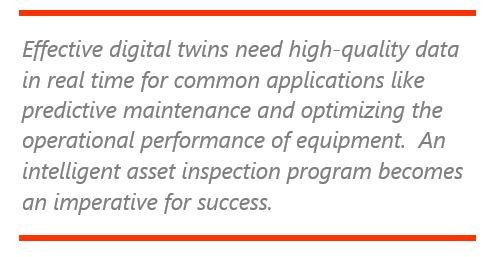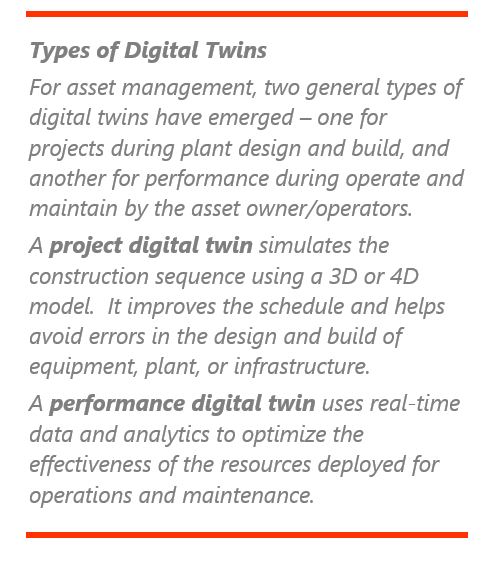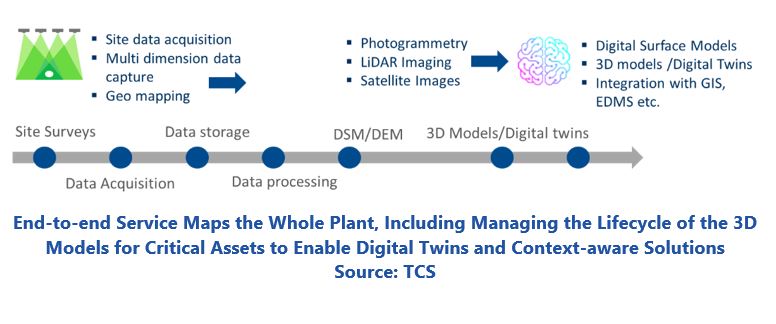

To be responsive in these dynamic and somewhat chaotic times, oil and gas companies need systems that provide real-time visibility and flexibility. A digital twin, by definition, replicates attributes of a physical asset. Digital twins enable oil and gas companies to respond with fact-based decision support for the industry’s challenges, which can be particularly helpful considering the added adverse impact of the COVID-19 pandemic.

Predictive maintenance using data from a particular piece of equipment has been a key driver for adopting digital twins. Many organizations have expanded the scope to include improved operational performance of the equipment to augment the control systems. As the scope of a digital twin expands, it requires additional data from multiple sources. Managing the digital twin models and data quality becomes an imperative for success.
Once a digital twin of a physical asset has been deployed, it is vital to keep it current to be effective for real-time decision support. The twins need to be updated and re-verified frequently enough to qualify as real-time. An intelligent asset inspection program provides a foundation for successful digital twins and overall digital transformation in the oil and gas industry.
Imbalances between supply and demand occur periodically in the oil and gas industry as geopolitical events, adoption of green energy sources, and other market forces cause either price decline (as with the current pandemic) or price spikes as have occurred in the past. To 
The combination of the recent excess production of oil combined with the pandemic became a “perfect storm” showing the need for digital transformation to manage risk and achieve sustainability. Real-time visibility, responsiveness and flexibility have become critical to business survival during these extremely dynamic conditions.
Today, roughly 63 percent of the oil field assets are past the halfway point of their expected lifetimes. This adds stress on knowing the precise status of your equipment. Digital twins enable oil and gas companies to respond with fact-based decision support for the industry’s challenges including production imbalances, rapid changes in global economic conditions like with the COVID-19 pandemic, and equipment reliability issues. To be responsive in these dynamic and somewhat chaotic times, oil and gas companies need systems with real-time visibility and flexibility provided with digital twins.
Several issues impede successful digital transformations in the oil and gas industry and thus realization of the associated benefits. Many operators and independent exploration and production (E&P) firms have confronted challenges developing effective digital strategies. A broad scope and “big data” approach require deep domain skills in multiple applications and complex systems integration. This approach evolves into a comprehensive custom project with extensive data management, data quality, and integration issues. By the time a custom digital transformation is implemented, internal system changes (applications and business processes) and external market dynamics require further changes – with delayed completion.
To deliver the promise of digital transformation with digital twins, automation and other digital tools, the data used for analytics, prediction and automation needs to be of high quality, 
Critical components of a digital twin – often glossed over – involve comprehensive data management in four areas:
Analytics plays two roles here. The first involves the algorithms or models that provide insights to the ongoing operations and related business processes. The second, and often less recognized role, involves data formats and integration from the various components of the enterprise. Some obvious issues include unit of measurement (metric or English) and synchronizing the time stamps.
Digital twins, by definition, replicate attributes of a physical asset. Sometimes this involves simulated data for training and what-if analysis. Usually, real-time data is incorporated to monitor the condition of an asset for predictive maintenance, optimizing operational performance, or managing perturbations. These digital models put additional pressure on the need for real-time data for analytics and associated insights for real-time decision support.
A real-time digital twin requires existing data and models to be updated continuously with the changes in the assets and the associated decision support systems. The volume of data generated in the oil and gas industry is measured in petabytes and growing. The data needs to be verified, classified, organized, and then presented to the right stakeholders at the right time in the right format to feed the digital twins.

How recent qualifies as real-time? This depends on the application and type of decisions being supported. In general, adoption of digital twins has quickened the pace and generated a demand for more timely data. Manual data collection is too slow and error prone. Studies made in the 1980s to explain the need for barcode readers showed that paper forms and manual data entry generated transactions with a 10 percent error rate. This low data quality renders a digital twin useless for decision support. Automated data acquisition is needed to keep the data current and of high quality. This includes inspections that are performed through various acquisition channels such as drones, fixed wing aircraft, satellites, video capture, Internet of Things (IoT) sensors, and SCADA systems. This is in addition to the usual oilfield data like seismic, well logs, reservoir performance, and more. To provide useful decision support, integration with operational technology (OT) is needed to provide quantifiable and actionable results.
Tata Consultancy Services (TCS) recently briefed ARC on its capabilities related to Business 4.0 and digital twins. This includes capabilities to provide digital twins with the needed real-time data, data quality, and systems integration.
The TCS Business 4.0 model – when applied to the oil and gas industry - includes these themes:
According to the company, the TCS Business 4.0 enterprise builds on a strong ecosystem of software and platforms that enables information integration with actionable output to the right entity in the right context at the right time for more effective and responsive decision making. Data democratization is a foundation for a TCS Business 4.0 approach with integration, distribution, and availability across the enterprise. For example, digital twins of assets allow simulations for potential changes and upgrades and operational monitoring of existing assets.
Predictive maintenance (PdM) has been a key driver for the adoption of digital twins. Typically, a performance twin starts with predictive maintenance because of the obvious and significant economic benefit and very short payback period for preventing unplanned downtime and the associated lost revenue. Here, a digital twin monitors the condition of an individual machine. Many have expanded in scope to include improved operational performance of the equipment. The process control system continues to control the process, which involves multiple pieces of equipment. The performance twin for a machine augments the control system by focusing on the proper functioning of a piece of equipment.
 Data Sources and Analytics Expand
Data Sources and Analytics ExpandAs the scope of a digital twin expands, it requires more data, which often comes from multiple sources. The analytic processes start to incorporate more data with increased diversity from various parts of the business. The effect becomes an integration of these parts into a new whole – the digital twin.
An intelligent asset inspection program becomes an imperative for success. The operational status of a modern asset uses input from multiple sources of data including aerial surveillance data, sub-surface surveillance data, remote sensing, SCADA and other inputs like manual or visual inspections.
This input data comes from different sources/companies. In addition, integration between the OT and back office IT is usually required. These models determine how physical assets perform both in real time and under various conditions for what-if simulations.
Once a “digital twin” of a physical asset has been created, it is vital to keep it current with changes to how the asset operates. To be useful for both real-time monitoring and simulation, the status of the asset needs to be accurate and up to date. The business process for engineering changes needs to include the digital twin. Inspections to keep the model current provide additional information regarding operational changes.

An asset inspection program provides data and a business process to maintain digital twins. The program also supports planned upgrades and maintenance schedules. A framework for acquisition, processing, updating, maintaining, and reporting the complex set of data enables effective integration and use of the acquired data. When combined with intelligent asset inspection, digital twins help optimize performance and extend asset life.

A digital twin of a tank farm with the crude oil inventory and available storage is an example of a useful tool for responding to the current oil glut and low prices exacerbated by the COVID-19 pandemic. This type of digital twin covers a broader scope beyond a single piece of equipment. The deployment is best done as part of an intelligent asset inspection system to manage data and keep the model current.
For a digital enterprise, the digital twin and associated data have a significant value delivered through business processes and decision support. To remain valuable to the enterprise, digital twins need to be updated and re-verified frequently enough to qualify as real-time for effective decision support.
The path to become a data-driven, digital- or a Business 4.0-based company is built on the accessibility of verified, good quality, and current data. An automated intelligent asset inspection program is a foundational aspect for successful digital transformation in the oil and gas industry.
TCS Business 4.0 is a trademark of Tata Consultancy Services.
Additional insights are available in this podcast interview with Jan Erik Johansson, Oil & Gas Industry Advisor, TCS: https://www.buzzsprout.com/898474/4617674
ARC Advisory Group clients can view the complete report at ARC Client Portal
If you would like to buy this report or obtain information about how to become a client, please Contact Us
Keywords: Digital Twin, Digital Transformation, Oil and Gas, Data Quality, TCS, ARC Advisory Group.

